When you live in a place to which the adjective “small” is often applied (“small Island,” “Canada’s Smallest Province”, etc.), it’s easy to become a little obsessed with issues of relative geography. Just how small? So I built a little experiment — The PEI vs. The World Machine — to allow comparisons to be made. Like How big is Charlottetown’s airport compared to Toronto’s? or How big is the neighbourhood I grew up in compared to the neighbourhood where I live now? or How does Miami Beach compare to Cavendish Beach?.
Try it it for yourself: as you zoom one map, the other will zoom in sync. You can scroll either map to any location (meaning, of course, that you can use this to compare two places that aren’t Prince Edward Island too!).
Note: as latitude changes, so does the scale of the map, so watch the scale bar in the bottom-left of each map.
If you’re playing the home game, you’ll have noticed that suddenly, on Saturday night, the wind came up, the windmills started to turn, and PEI started to generate a lot of wind energy. Indeed, for a lot of yesterday we were approaching or going over 100% of electricity generation from wind. If you got up early this morning on Prince Edward Island — before 5:30 a.m. — and turned on the lights, the electricity powering those lights was coming from the wind. Remember, you can also follow @peiwind to be notified when circumstances conspire to tip us over 100%.

 From The Guardian, December 9, 1916, and generous appreciation of the janitor at Prince Street School:
From The Guardian, December 9, 1916, and generous appreciation of the janitor at Prince Street School:
Last evening on behalf of the parents, pupils, and ratepayers connected with Prince Street School, Mr. C. W. P. Seale, of this City, waited upon Mr. Augustus Mitchell, janitor of the school and surprised him with the presentation of a purse of gold and the following address. Mr. Mitchell expressed his surprise and only consented to accept on being assured that it was a farewell offering on the part of practically everybody connected with the school and in appreciation of the splendid service he had given continuously since he became connected with the school, a service which included, in addition to the ordinary work of a janitor, a kindly and gentlemanly oversight of the children in attendance:
Mr. Augustus Mitchell,
Upper Prince Street School.
Dear Mr. Mitchell:
We, the friends of Upper Prince Street School, desire to express our appreciation of the manner in which you have performed your arduous work as Janitor. We are aware that when you first took charge of our school, you found matters not too pleasant on account of a lack of proper care of the school both inside and out. After years of hard work on your part, both, school and grounds have become a credit to the city and a joy and pleasure to the school children. Its freedom from disease germs, on account of the cleanliness of the rooms, enables parents to send their children with confidence that, so far as the school building is concerned all is well. We doubt that in the whole of Canada there is a neater kept school grounds than those of Upper Prince, for which we tender you our sincerest thanks.
We ask, therefore, as as small token of our appreciation of your labor, not only in connection with the school grounds, but in your watchful over the tender youths in attendance here, that you will accept this gift with the humble hope that you may long be spared to continue your good work with us.
– On behalf of the Parents and Pupils of Prince Street School.
The Guardian heartily commends the above sentiments express in the address. Prince Street School has for some years been a recognized beauty spot in the city and the credit for this is entirely due to Mr. Mitchell’s tireless efforts and continuous care. The sentiment and the gift will be appreciated by the teachers and the pupils, all of whom hold Mr. Mitchell in the highest esteem. The city is fortunate in having in such an important and responsible position a man who is so thoroughly reliable and competent to perform the duties entrusted to him.
I was chatting with my friend Morgan this morning, and he sent me a link to his CV, which contained a link to his Speaker Deck. Which was a new website for me. So, by way of experimenting, I dug through my various digital archives and tracked down the nine public presentations I’ve made in the last six years and created my own Speaker Deck. It’s an interesting way to time-travel.
Cosm, which I’ve been using as the repository for the electricity data I’ve been logging for Prince Edward Island is a great resource, but its graphs are static and not particularly useful for dynamic exploration of data. So I’ve been experimenting with local logging of this data, and then using the Google Charts Tools to visualize the archived data.
The result is this graph, which is dynamic — you can change the time period viewed, and examine anywhere from a minute’s worth of data to a year’s worth (there’s only a week’s worth of data there now, so that’s as far out as you can see as I write this post).
By exploring the graph, you can see how Prince Edward Island’s electricity usage (the “Load” line in blue) over the course of the day and the course of the week. For example, compare a Sunday morning to a Monday morning to see what effect not going to work has on electricity usage. As the archive of data grows, we’ll be able to explore seasonal changes as well.
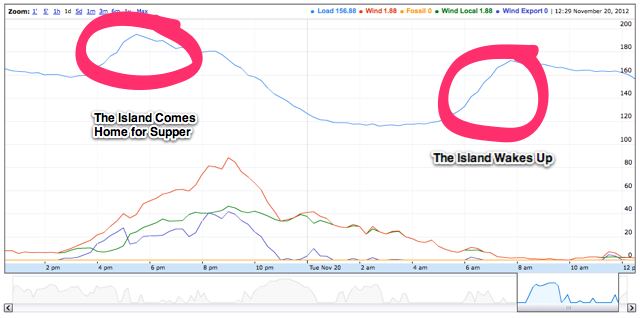
We held an open house yesterday for TeacherNet, our home and school-supported wireless pilot project at Prince Street School. We had a good audience of teachers, principals, parents, students and administrators, and, after the formal proceedings, a healthy discussion of education technology issues, wireless and otherwise. You can grab the slides and see a video of the open house on the TeacherNet site.
We’ve also started to publish usage graphs for the network; these come from Cloudtrax.com, the management portal for the network, and are grabbed for local usage with some code I hacked together. Here, for example, is an updated-every-hour graph of usage over the last 24 hours:

The open house concluded with some happy news from Bell Aliant, our bandwidth sponsor: Paul Murray announced a 6-month extension of the FiberOP service provided at no cost to the project.
At our PEI Home and School Federation board meeting this week we got a demonstration of the extent to which we limit our children’s access to technology in the name of protecting them from technology and protecting technology from them.
Ghenyk, a grade 9 student at Birchwood Intermediate School, walked us through the process of trying to take an photograph from a USB stick and edit it on a PC in the school library. It was an almost-comical display of technology-gone-wrong, with numerous “Windows needs to install driver software” pop-ups, and, once the USB stick was recognized, the need for “shhh, don’t tell anyone how to do this” hacks to open Windows Explorer to be able to actually see the files on the stick.
It would be truly comical if it wasn’t so spirit-numbing: somehow we have managed to take the most engaging and flexible technologies that humans have ever invented and, in the name of “protection,” turned them into inflexible, hostile technologies that stymie rather than enliven student learning.
And yet we regard these limitations we’ve placed on the system as rational: the frustrating dance required to extract a photograph from a USB stick means everything’s working exactly as it’s supposed to.
The really frustrating thing? This isn’t anybody’s fault.
Everyone in the education system, from the Minister on up, is doing their job.
The provincial IT Shared Services branch, which maintains the technology, is doing its job to maintain computers and the network.
The Technology in Education branch of the Department of Education is doing its job to filter the Internet and locking down the computers to prevent modifications.
The Minister, through his Minister’s Directive on Acceptable Use of Communication and Information Technology, is doing his job to ensure that parents and students know and understand the limitations placed upon them.
Everyone is doing their job, and yet the end result is a hobbled system that, every day, frustrates teachers and students, and turns them against the technology rather than having them embrace it.
Sometimes this frustration boils over, and its absurdity sees the light of day. Increasingly we’re starting to see students themselves rattle the bars of the digital cages we’ve forced them into.
Last month, for example, Ben, at Stonepark, launched a campaign to see wireless Internet provided for students in his school, and this became the topic of a story on CBC Island Morning:
Back in 2011, Jack, a student at Birchwood Intermediate, was asked to test Flip cameras that had been acquired by the Teachers’ Resource Centre to see if they could be used by students to shoot videos. As you might imagine, the answer was “no,” and Jack shot a video to demonstrate why:
Jack’s teacher at Birchwood told us that Jack made the video, in part, to try to change things for the better so that his younger brother wouldn’t be subject to the same onerous technology situation. Alas his brother is now in Birchwood, in the same class Jack was once in, and the situation is at is ever was.
And it’s not just students: principals and teachers are finding ways to route around limitations, doing things like installing bootleg networks to allow them to access the actual Internet. At Prince Street Elementary School we have a home and school-supported and system-sanctioned wireless Internet pilot project that provides 20 Mbps of drastically-less-filtered bandwidth to educators; here’s how one teacher is using it:
I spend a lot of time at home finding appropriate sites and activities around what the children are learning and bring them into my classroom. Before the wireless this meant cutting and pasting the sites into an email to send myself which I would open at work. Many times I would not be able to access the sites on my school computer. I would need to give the site addresses to our IT person or to the principal so they could arrange to have the sites approved. This was a lengthy process and often by the time I was able to get into the sites, my children had gone onto other interests, needs or skills.
In other words, they’re using the wireless network as a simple way of routing around the filtering they encounter on the official network.
Conversations about technology in education are difficult ones because the older generations — parents, teachers, administrators, politicians — are often completely unaware of what “technology in education” means. We tend to view it as a force to be contained and feared. Or a “side dish” that can add to but is not central to the process of learning, often expressed variations of the “there weren’t any computers in the schools when I was there and I turned out all right” line.
Inside the digerati it is common to confront this situation with derision: if only administrators and politicians would “get with it” and understand the need for unfettered high-quality education technology (and then fund it), everything would be okay; those of a contrary point of view are regarded as “backwards” and not worthy of dialogue.
Neither those inside Internet culture nor those on the sidelines are making much effort to understand the other: the “I turned out all right” set seem comfortable in their ignorance while being regarded by the digerati as simply beyond reach, and thus not worth of advocacy or education.
Nobody seems to making much of an effort to take a broad systematic view that squares our dramatically changed world with the beliefs and attitudes of a population unaccustomed to its promise.
Which is why, fundamentally, this isn’t a resource issue, but rather a matter of culture and educational philosophy.
I have the benefit of insight into this from the unique perspective of a child schooled in Ontario in the early 1970s, which was the last time that education technology was going to change everything: Living and Learning: The Report of the Provincial Committee on Aims and Objectives of Education in the Schools of Ontario, known otherwise as the Hall-Dennis Report, was a document that had a profound effect on my public school education. Here’s an excerpt:
A whole new field of exciting educational aids and facilities is becoming available for our use. Educational television is currently the most spectacular of these but the media may be as old as the cave drawings or as new as computer-assisted instruction. Educators ought to employ every conceivable device and means that society can make available. But a word of caution is in order. The majority of audio-visual aids that the Committee has seen in use have been employed in a narrow, didactic manner and with groups of children all presumed to be learning the same thing at the same time. Our perception of how learning takes place, and of the kind of teaching that facilitates the process, requires that the teacher understand the use of a variety of techniques in the interests of every child. Information contained on film, records, and tape, and in pictures and books must be accessible to each child when he needs it. The technology to make this a reality is feasible; the dangers of thought control, passivity, and a stultifying uniformity are too grave to permit indiscriminate use of films and educational television.
By the time I started school in 1972, the changes to Ontario education recommended by Hall-Dennis were in full flower: schools without walls were under construction; televisions were purchased for classrooms; the notion of a “student-centred education” was in the air.
By the time I hit grade 7, in 1979, though, most if not all of these revolutionary corner-turns had come to an end, and the balance of my education was, while certainly markedly different from that of my parents’ generation, in effect a “recoil” back to a pre-Hall-Dennis model.
Why? Among myriad reasons the foremost was that the education system went through a dramatic infrastuctural and philosophical change but did so without sufficient thought as to how to retrain teachers and parents to embrace this change. They changed the hardware and the operating system, in other words, but not the software: the result was that teachers and parents rebelled. The schools-without-walls quickly had walls, literally and figuratively, reconstructed inside them. While vestiges of the Living and Learning philosophy remained, the backlash against its thinking was profound and long-lasting.
And we are there again.
The use of technology in education — and even writing that seems as absurd as writing “the use of oxygen in breathing” — and the availability of the Internet, has changed everything.
It has rebalanced the relationship between “teacher” and “student,” reduced the need for rote memorization of facts to an absurd make-work project, seen the ability to think critically and navigate through a sea of information become preeminent, and changed our notion of geography and time and friendship.
And it has forced us reconsider our definition of “learning resources” from “textbooks that we purchase and control the contents of” to “the collected knowledge of all humankind, good and bad, at your fingertips.”
Central to this all is a fundamental lack of control: where once parents, educators and administrators could finely control and manage the education experiences of students because we had complete control over the setting and the resources, by allowing the network into the school, we now have no control at all.
And that is terrifying.
Rob Paterson expresses this well in his book You Don’t Need a Job (The Rise of the Network):
You manage a network by managing the health of the ecosystem. You cannot manage complexity directly. Think of how you really raise your children. You may pay attention to meal times, to brushing their teeth and so on. But what you really do, for better or for worse, is to provide an ecosystem. You create a culture that has a few rules for how things get done at home. Machine organizations try and manage everything, This is why they get overwhelmed and this is why people in them feel so bad.
Is it any wonder, in light of this terrifying new reality, that the software installed on every school computer is called, somewhat desperately, Full Control (software that, among other things, disables the Windows “Start” button for students).
Or that, in response to a PEI Home and School resolution calling for a simplification of the Acceptable Use Policy, the Minister of Education’s response was, in part:
The computer and information access can be a very dangerous process, and I believe the document adds clarity to the expectations of the users and should not be left to common sense of impressionable users to determine the suitability of their access.
Enlightened managers of digital ecosystems don’t installed software called “Full Control,” nor do they regard the Internet as a dark force from which our children must be protected to the exclusion of all else. These are the actions of a system under stress, of a system that’s running scared, not running proud.
It is in this environment that Ghenyk, Jack and Ben are saying, with enviable calm and consideration given the extent of the limits we put on them, give us better tools to help us learn.
I would like to humbly suggest that we listen to them.
Hall-Dennis said this about democracy:
Democracy implies the freedom to think, to dissent, and to bring about change in a lawful manner in the interest of all. It is a flexible, responsive form of government, difficult to describe in fixed terms. Democracy does not arise as a result of imposed or structured political practices, but as a dynamic, liberating force, nurtured by the people themselves. It can thrive and flourish only when its citizens are free to search continually for new ideas, models, and theories to replace outmoded knowledge in an effort to serve an ever-increasing populace tomorrow. A true democracy is a free and responsible society, and one aspect cannot exist or have meaning without the other.
I hold that the Internet and the technologies and attitudes surrounding it are the greatest tool we have ever built to allow the true expression of this democracy, to enable this freedom “to search continually for new ideas.”
When we seek to place arbitrary limits on this tool, to carve away vast swaths of the Internet because they are deemed inappropriate “social networking,” to take infinitely flexible machines and, in the name of “protection,” to kneecap them down the inflexibility of toasters, to cower in fear from the possibility that the Internet may inflict harm while ignoring its potential to do the opposite, we are, among other things, telegraphing clearly to our children that we do not trust them, that we do not regard them as responsible, and that they are not welcome to participate in this unfettered search for new ideas.
Our students are saying “give us better tools to help us learn,” and, despite having the keys to those tools in our hands, we are saying “no, sorry, dear: we know better.”
That is, beyond any immediate curricular impediment, an abgrogation of our responsibility to our democracy itself. It is also, as it happens, placing our children at a tremendous disadvantage in a society, and an economy, that has the network at its heart.
This has nothing to do with all our children will becoming computer programmers for a living, for what we are in the midst of is a much broader phenomenon that touches all aspects of society; Rob puts it this way:
Here is a phase shift from values that are rooted in an external locus of control to one that is rooted in an internal locus. We move from “belonging” to “self initiating.” We move from “obedience” to “participation.” We move from a leadership style that is a “manager” to one that is at the least a “facilitator” to at best one that is a “collaborator.”
If our schools exist to equip our children to be citizens, surely we must consider the challenges of being a citizen in a networked world to be primary among our goals. To do this effectively, we must look beyond our own terror at a new world we don’t completely understand and seem unable to control as we have been used to.
We must become uncomfortable with a system where, despite everyone doing their job, the result is frustrating to the point of being inoperable.
We must find a way clear to working together to become acclimated to the new chaos.
And we must stop blaming others for this situation and see it as a personal and collective responsibility to make it right.
And to start, we must simply listen (and feel a debt of gratitude) to Ghenyk, Ben and Jack.
Jane Ledwell presented an engaging talk, titled I Saw Your Name in the Paper, at the Confederation Centre Public Library earlier this week. She spoke about gender representation in the pages of Charlottetown Guardian, the result of her analysis of news stories in 51 issues of the paper this summer. You can listen to an interview with Jane on CBC’s Mainstreet:
In the visuals for her presentation Jane used Wordles quite effectively (me and Wordles go way back), and so, by way of tipping my hat, here is a Wordle of the words in the 10 comments to the Guardian’s own story about Jane’s project

As regular readers of the Guardian’s website will know, the comments there — all anonymous — are something read at considerable risk to one’s sense of happiness and community; in this case they ran the gamut from “what a pile of crap study” and “Interesting that we let our tax money … be used for this kind of garbage” to “This seals my long held conviction that the Advisory Council has outlived their usefulness and long time ago.”
There are alas, at this reading, no “thanks for your insights into media representations of women” or “it’s high time we looked harder at the barriers to gender equality in Island society.” So let those be my comments.
I took the cleaned up list of companies receiving PNP investment (derived from the list released by the Province of PEI last week), combined it (matching on company name) with the 2008 ClosedCorporations.org corporations data, and then geocoded the corporate contact address against the PEI civic address database.
The result was a CSV file with records for 379 companies (30% of the total 1354 companies on the original list) that could be identified by latitude and longitude.
I then took this CSV file and ran it through GPSBabel to create a KML file of the 379 companies that can be loaded into Google Earth or displayed on a Google Map.
It’s only when you see the data — and remember this is only 30% of the companies, that the location data is 4 years old, and the the geocoding process is imperfect — displayed on a map that you get a true sense of how pervasive the uptake of the PNP program was; here’s a snapshot of downtown Charlottetown, for example:
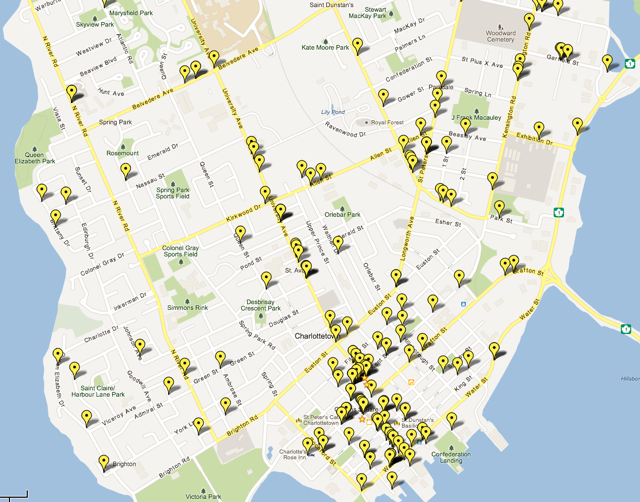
Google Earth has a much better interface for allowing multiple pins at the same location to be displayed; here’s a snapshot of a building on Water Street in Charlottetown, for example, showing 6 companies geocoded to the same location:
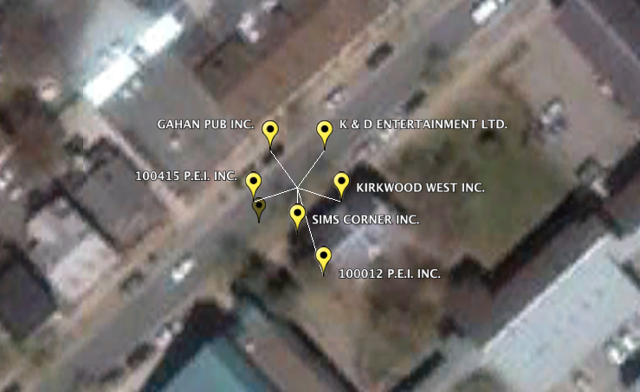
Companies, organizations and political parties are increasingly combining data about us gleaned from disparate sources to better target us as consumers; we have a right and a responsibility to educate ourselves about the tools of this trade, and one of the ways we can do this is to equip ourselves with information about companies by combining open data sources to see patterns and derive insights that wouldn’t otherwise be visible.
Update: here are some “heat maps” of the same data, created by uploading a slightly-modified CSV file (replacing the “name” column with the number 1, to weight each company with the same value) to myHeatMap.com. Because many rural addresses cannot be geocoded (“RR#3, Cornwall” for example), urban companies are over-represented on these heat maps (and the maps above too):
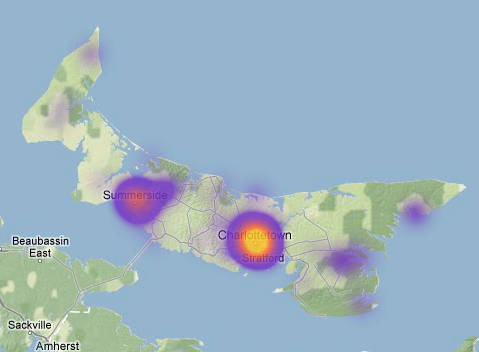




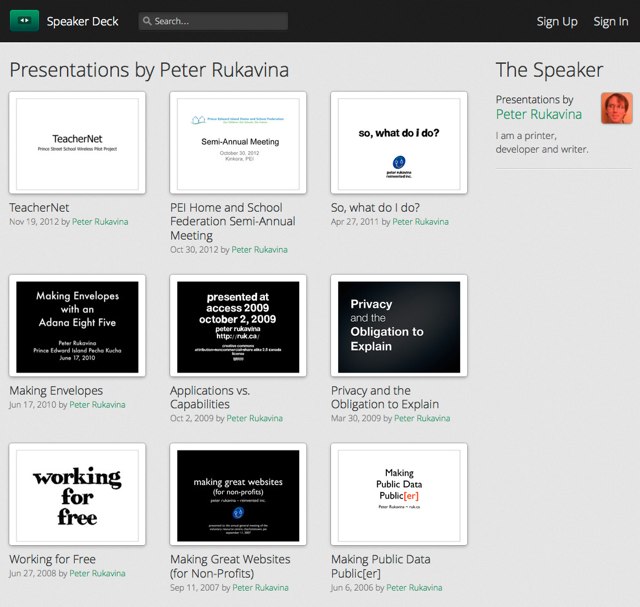
 I am
I am